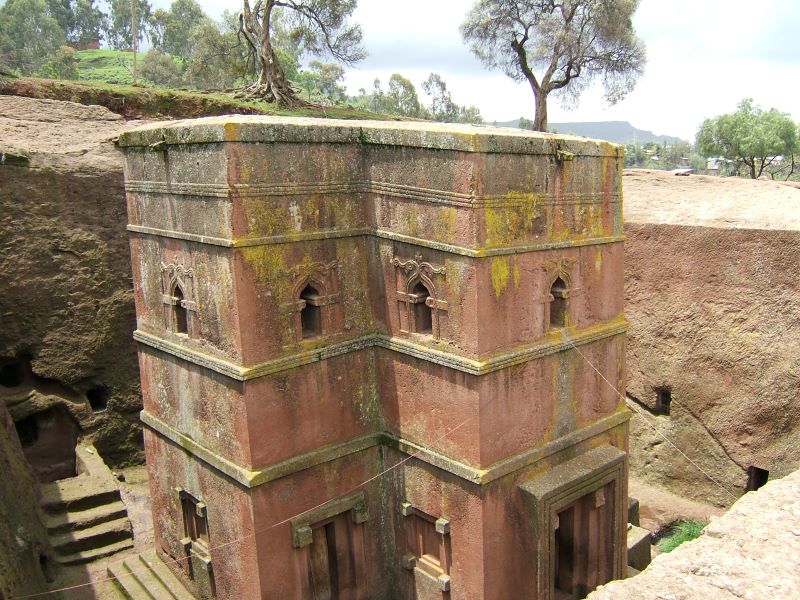Church of Saint George, Lalibela, Zagwe Dynasty.
Giustino, CC BY 2.0, via Wikimedia Commons
Throughout the advancement of humanity and the evolution of nation-states, several dynasties have come to play a role in shaping civilizations over centuries. Whether it be the Ming Dynasty, Han Dynasty, the Mongol Empire, Umayyad caliphate, or Yuan Dynasty among many others, one dominant factor is that they not only changed the evolution of their dynasties to various nation-states that we know today, but they have also contributed to several of the notable successes recorded in humanity in various fields of endeavor.
In Africa, one of such countries that draws reference to the contribution of dynasties to its evolution is Ethiopia.
Located in the Northeastern part of the continent or what would famously be referred to as the “horn of Africa”, the nation has experienced several dynastic rules. From the Aksumite dynasty to the Solomonic and Zagwe dynasties, these various dynasties have not only preserved Ethiopian sovereignty, especially from colonial conquests (Ethiopia is one of the African countries never colonized) but has also impacted greatly in their contributions to the progress of mankind.
The Solomonic Dynasty

Source:gill_penney [2], modified by Fulviusbsas, CC BY 2.0, via Wikimedia Commons
Arguably one of the longest dynasties in human history, with researchers ascribing its commencement from 1270 CE to 1974 CE, with others arguing that it began much further back in 982 BCE. The dynasty traces its origins from the biblical union of Solomon, the Israelite King, and Queen Sheba who was touted by scholars to have come from the kingdom of Axum. The result of this union resulted in the birth of Melenik I, who became the first Ethiopian emperor.
The dynasty played a key role in shaping the trajectory of the country. According to the Kebra Nagast (the glory of kings), an ancient text that outlines how Menelik 1 was able to tie Ethiopia’s future kings to the biblical line of King David, his role and influence would later shape the growth of the Ethiopian Christian Orthodox Church which played a significant role in the political, cultural and governance outlook of Ethiopia.
Aside from its great influence in the growth of Orthodox Christianity, the Solomonic rulers also played a key role in the establishment of profitable trade routes as a result of its proximity to the Indian Ocean and Red Sea, architectural and scholastic advancements as could be seen through the ancient manuscripts and scripture texts, as well as exhibiting a strong military capability through its opposition of outside threats as could be seen through the successful push back of Italian invasion in the 19th and 20th centuries.
The Zagwe Dynasty

Source: allaboutEthio
Unlike the Solomonic dynasty, the Zagwe dynasty did not enjoy the historical line of succession and was viewed as a reign of illegitimate usurpers. Between the period of 900 CE to 1270 CE, the Zagwe dynasty enjoined a bit of stability in governance from the time of its first ruler – King Mara Takla Haymanot up until the 13th century when opposition began to rise against the famous Zagwe King whose name is lost but chronicled to be known as Za-Ilmaknun which also translates to “The Unknown” but whom the famous historian and scholar Taddesse Tamrat possibly identifies as Yetbarak who rose to rulership after succeeding his father King Lalibela but was later killed after the Battle of Ansata.
As a dynasty, the Zagwe line was famous for its architectural accomplishments, especially the rock-hewn churches that are situated in Lalibela. To provide alternatives to Pilgrimages to the Holy Land due to the growing Islamic campaign, King Labelila claims to have been inspired to build a second Jerusalem in Ethiopia.
According to the UNESCO World Heritage Convention “The 11 medieval monolithic cave churches of this 13th-century ‘New Jerusalem’ are situated in a mountainous region in the heart of Ethiopia near a traditional village with circular-shaped dwellings. Lalibela is a high place of Ethiopian Christianity, still today a place of pilgrimage and devotion. It is also recognized as a World Heritage site.
Governance under the Zagwe dynasty was theocratic and leveraged the influence of religion to solidify its authority over the people relying heavily on alliances with the nobles and clergy. As an economy, the dynasty was no different from the Solomonic dynasty. Leveraging its access to the Red Sea and Indian Ocean, it maintained trade links with other countries operating within the region.

Okechukwu Nzeribe works with the Onitsha Chamber of Commerce, in Anambra State, Nigeria, and loves unveiling the richness of African cultures. okechukwu.onicima@gmail.com





